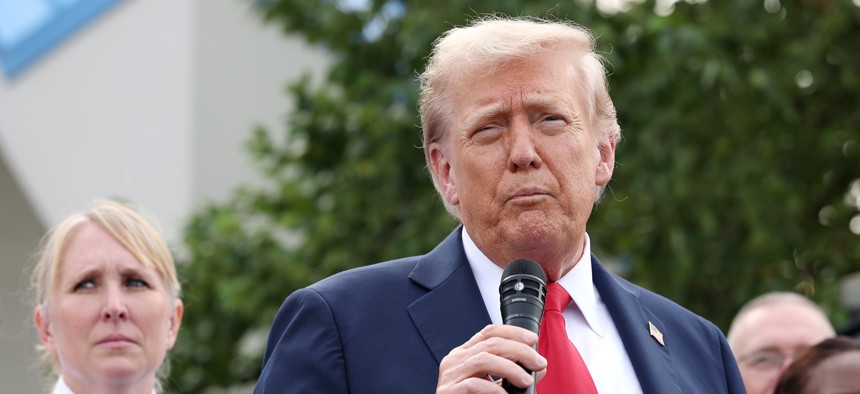
President Donald Trump visits the U.S. Park Police Anacostia Operations Facility on Aug. 21, 2025, in Washington, D.C. Trump must issue an alternative pay plan for federal employees by the end of the month. Anna Moneymaker / Getty Images
Trump’s pay freeze plan expected by end of month
The president must publish his alternative pay plan by Aug. 31 if he wishes to avert automatic large-scale increases to locality pay under the Federal Employees Pay Comparability Act.
President Trump has just nine days to issue his likely plan to freeze federal employees’ salaries in 2026, before sizeable automatic and across-the-board increases take hold.
Each August, the president must issue an alternative pay plan, declaring an economic emergency to avert the automatic implementation of sizeable increases to locality pay due to the 1990 Federal Employees Pay Comparability Act. Administrations of both parties have bemoaned the way that the law calculates those automatic adjustments, hence the annual sidestep of that provision.
This year has been an unusual one for pay raise observers. Although presidents generally announce their proposals for federal employee compensation with the submission of their budget proposal to Congress each spring, the Trump administration intentionally eschewed that process this year, because, as Russell Vought said last month, it “wasn’t in our interest” to do so. Vought justified only sending a partial budget to Congress as to avoid issuing “confusing” messaging to members of the public, since Republicans were also working on budget reconciliation during that time period.
Still, passback documents—the Office of Management and Budget’s instructions to agencies preparing their budget requests—in April indicated the president would pursue a pay freeze for federal workers in 2026. Thus far, congressional appropriators have not included language in their funding bills regarding federal employee pay, essentially endorsing the White House’s plan.
In his final year in office, President Biden issued a 2.0% average pay raise for 2025, split between a 1.7% across-the-board increase in basic pay and a 0.3% increase in locality pay.
Trump proposed pay freezes in three of the four years of his first term, though Congress overruled him each time, providing raises between 1.4% and 2.6%. In 2020, he proposed a 1% across-the-board increase only to reverse course and again support a freeze. Congress adopted the 1% increase that year.
After issuing an alternative pay plan, Trump must also publish an executive order in December formally implementing the plan.
Share your news tips with us:
Erich Wagner: ewagner@govexec.com; Signal: ewagner.47
NEXT STORY: Did you forget to file for Social Security?







